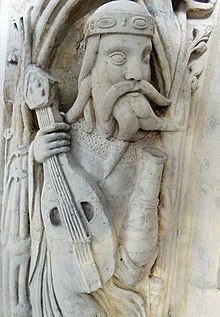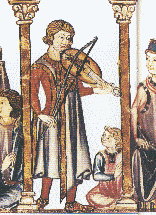Fidel
Fidel , even fiddle ( Old High German Fidula , Middle High German fidel, fyddel, videl ) is an umbrella term for a number of the sheets painted lute instruments that are not necessary, but in the form in their technique and attitude of the violin are similar. These include string instruments that were differentiated from the Rebec or Rotta in the Middle Ages . In addition, small string instruments used in folk or traditional music around the world are unspecifically designated as fiddle . English Fiddle stands for non-classical playing styles of the violin in contemporary popular and traditional ethnic music such as folk .
Spelling and related words
Before the 19th century, the spelling was not standardized. In addition to fidel , fiedel , there are also spellings beginning with v . A connection between the v-spelling and Italian viella , Spanish vihuela , French. vièle , vielle cannot be produced, however, since the f-sound in Middle High German was written with v rather than f at the beginning of the word (see V ). The origin of the word can be traced back to Old Provencal . A relationship with viola (Italian viola ) is likely, but the details are controversial.
Musicology has largely decided to use the spelling Fidel for the historical string instrument, according to the Lexicon Music in Past and Present (MGG). Likewise, the Basel University of Applied Sciences Schola Cantorum Basiliensis , probably the only music academy in the world where you can study Fidel as a major.
The fiddle in this sense corresponds to the English fiddle . The fiddle is used in country and folk music instead of the modern violin . String instruments with related names are Vihuela , Schlüsselfidel and Fiðla .
Historical fiddles
As a string instrument in medieval and renaissance music, the rebec was of particular importance alongside the fiddle . While the medieval fiddle had a flat bottom and a pegboard with vertically positioned front or rear tuning pegs , the Rebec had a curved back and pegs protruding to the side. The bow consisted of a curved stick that held the horsehair string taut.
The historical Fidel (also called Fidula ) can be traced back to the 11th century; In the 12th century, fiddles often appear in portal sympana as instruments of the 24 elders of the Apocalypse . Fiddles usually had five to seven strings in fifths and fourths , pegs inserted from the front or back and an oval or waisted body. The fiddle was the most important instrument of the troubadours and minstrels , Hieronymus von Moravia handed down the most widespread moods of the fiddle in the 13th century, beginning (in brackets) with the drone :
- (d-) Gg-d'-d '
- (d-) Gg-d'-g '
- (G-) Gd-c'-c '
The tunings 1 and 3 seem to indicate that the fiddle sometimes used double strings, so, from a purely musical point of view, sometimes only had three playing strings, similar to the Rebec. In the 15th century, the fiddle developed into the lira da braccio , which had two drone strings next to the fingerboard in addition to the five playing strings . The tuning of this instrument was dd′-gg′-d′-a′-e ″.
The string instruments developed from Fidel and Rebec. The viola da braccio of the 15th century was very similar to today's violin. For the descendants of medieval fiddles in Eastern European folk music, see: Husle . An old form of a fiddle that was played in Poland until the end of the 19th century is the suka . The type of Suka that has been handed down in drawings has been restored since the 1990s.
The manufacturers of fiddles in the 20th century included, for example, the workshop for historical musical instruments and fiddle making by Emmo Koch in Bremen and in Mittenwald Karl Frank (six-string Mittenwald fiddles tuned in fourths that can be played on your lap ).
Modern fiddles
The name Fidel, formerly also known as Neue Fidel , is also common for a string instrument that did not appear until the 20th century. It is a modernized form of the viola da gamba , a historical string instrument that was rediscovered in the course of historical performance practice in the 20th century. The fiddle corresponds to its historical model in playing style and mood. In the middle of the 20th century, violin makers developed the fiddle, a more robust, cheaper form of the viol to make this instrument easier for beginners. At some music schools it is still taught as an entry-level instrument.
There are fiddles in different pitches, the most common is the high treble register. In contrast to the viol , the fiddle is strung with steel strings. Many fiddles are tuned using mechanics instead of pegs, but there are also variants with pegs and fine tuners, similar to violins. It is played like the treble viol between the legs or placed with the body on the lap. The neck protrudes upwards. Fiddles have five to six strings in fourth-third tuning and a fretted fingerboard.
Usual mood:
- 5-string: gc′-e′-a′-d ″
- 6-string: dgc′-e′-a′-d ″
literature
- Rainer Ullreich: Fidel. In: Ludwig Finscher (Hrsg.): The music in past and present . Second edition, factual part, volume 3 (Engelberg - Hamburg). Bärenreiter / Metzler, Kassel et al. 1995, ISBN 3-7618-1104-7 ( online edition , subscription required for full access)
Web links
Individual evidence
-
↑ Some exemplary sources:
- Alec Robertson, Denis Stevens: History of Music in Three Volumes. Vol. 1. Munich 1965, p. 197 ff.
- Musical instruments in the world. Prisma, Gütersloh 1981, p. 202 ff.
- Paperback of musical instruments. Humboldt TB 1973, p. 36: "THE FIDEL (fidule, vielle), the most important medieval string instrument ..."
- David Reck: Music of the World. Hamburg 1991, p. 119: "Strikethrough lutes (generic name: Fidel) are to be found in just as astonishing variety as the plucked long-necked and short-necked lutes."
- Eberhard Thiel: Subject dictionary of music (= Kröner's pocket edition . Volume 210). 3rd, improved edition. Kröner, Stuttgart 1977, ISBN 3-520-21003-7 , p. 153: "Fidel"
- ↑ Rainer Ullreich: Fidel. In: Ludwig Finscher (Hrsg.): The music in past and present . Second edition, factual part, volume 3 (Engelberg - Hamburg). Bärenreiter / Metzler, Kassel et al. 1995, ISBN 3-7618-1104-7 ( online edition , subscription required for full access)
- ^ List of instruments that are taught at the Schola Cantorum Basiliensis
- ↑ Erich Valentin: Handbuch der Musikinstrumentenkunde. Gustav Bosse, Regensburg 1954, p. 427.
- ↑ Erich Valentin : Handbuch der Musikinstrumentenkunde. Gustav Bosse, Regensburg 1954, p. 455 ff. ( Instrument maker ).
- ↑ Erich Valentin : Handbuch der Musikinstrumentenkunde. Gustav Bosse, Regensburg 1954, p. 426.


